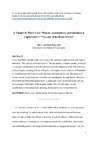Identificador persistente para citar o vincular este elemento:
https://accedacris.ulpgc.es/handle/10553/52642
| Campo DC | Valor | idioma |
|---|---|---|
| dc.contributor.author | Pérez-Gil, María del Mar | en_US |
| dc.date.accessioned | 2018-12-12T12:28:38Z | - |
| dc.date.available | 2018-12-12T12:28:38Z | - |
| dc.date.issued | 2016 | en_US |
| dc.identifier.issn | 0011-1619 | en_US |
| dc.identifier.uri | https://accedacris.ulpgc.es/handle/10553/52642 | - |
| dc.description.abstract | I argue that Plato’s parable of the cave is one of the intertexts employed in Angela Carter’s short story “The Lady of the House of Love.” The protagonist, a female vampire, is likened to a prisoner condemned to live in the shadows under the obligations of her role. Drawing on Luce Irigaray’s reading of Plato’s allegory, I will explore Carter’s critique of femininity as a condition associated with mimetic processes that imprison women. The protagonist mirrors several female characters that mime and ventriloquize the male desires. However, she imitates her intertextual predecessors in anamorphic ways. In Platonic terms, she can be considered a “bad copy” of the original models. Yet, as I will argue, it is her imperfection, or bent intertextual mirroring, that opens the way for her liberation. | en_US |
| dc.language | eng | en_US |
| dc.relation.ispartof | Critique - Bolingbroke Society | en_US |
| dc.source | Critique - Studies in Contemporary Fiction [ISSN 0011-1619], v. 57 (5), p. 512-520 | en_US |
| dc.subject | 6202 Teoría, análisis y crítica literarias | en_US |
| dc.subject | 620201 Crítica de textos | en_US |
| dc.subject.other | Bent mirror | en_US |
| dc.subject.other | Deleuze | en_US |
| dc.subject.other | Intertextuality | en_US |
| dc.subject.other | Irigaray | en_US |
| dc.subject.other | Plato’s cave | en_US |
| dc.title | A Vampire in Plato’s Cave: Mimesis, Anamorphosis, and Simulacra in Angela Carter’s “The Lady of the House of Love” | en_US |
| dc.type | info:eu-repo/semantics/Article | en_US |
| dc.type | Article | en_US |
| dc.identifier.doi | 10.1080/00111619.2016.1141390 | en_US |
| dc.identifier.scopus | 84978471529 | - |
| dc.identifier.isi | 000381051200003 | - |
| dc.contributor.authorscopusid | 48761882200 | - |
| dc.description.lastpage | 520 | en_US |
| dc.identifier.issue | 5 | - |
| dc.description.firstpage | 512 | en_US |
| dc.relation.volume | 57 | en_US |
| dc.investigacion | Artes y Humanidades | en_US |
| dc.type2 | Artículo | en_US |
| dc.contributor.daisngid | 8964714 | - |
| dc.utils.revision | Sí | en_US |
| dc.contributor.wosstandard | WOS:Perez-Gil, MD | - |
| dc.date.coverdate | Octubre 2016 | en_US |
| dc.identifier.ulpgc | Sí | es |
| dc.description.sjr | 0,281 | |
| dc.description.sjrq | Q1 | |
| dc.description.ahci | AHCI | |
| dc.description.erihplus | ERIH PLUS | |
| item.grantfulltext | open | - |
| item.fulltext | Con texto completo | - |
| crisitem.author.dept | GIR Estudios sociolingüísticos y socioculturales | - |
| crisitem.author.dept | Departamento de Filología Moderna, Traducción e Interpretación | - |
| crisitem.author.orcid | 0000-0002-4656-0025 | - |
| crisitem.author.parentorg | Departamento de Filología Moderna, Traducción e Interpretación | - |
| crisitem.author.fullName | Pérez Gil, María Del Mar | - |
| Colección: | Artículos | |
Citas SCOPUSTM
2
actualizado el 08-jun-2025
Citas de WEB OF SCIENCETM
Citations
1
actualizado el 08-jun-2025
Visitas
265
actualizado el 14-dic-2024
Descargas
464
actualizado el 14-dic-2024
Google ScholarTM
Verifica
Altmetric
Comparte
Exporta metadatos
Los elementos en ULPGC accedaCRIS están protegidos por derechos de autor con todos los derechos reservados, a menos que se indique lo contrario.
